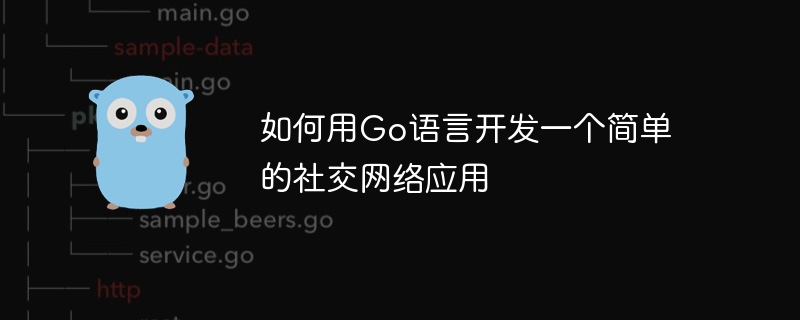

How to develop a simple social network application using Go language
Introduction
Social networks have become an indispensable part of people's daily lives. With the development of technology, it has become easier and easier to develop your own social network application. This article will use Go language as a development tool to introduce how to quickly develop a simple social network application.
Step 1: Design the database schema
Before starting development, we need to design the database schema. A typical social network application usually contains entities such as users, friend relationships, and posts. A relational database such as MySQL or PostgreSQL can be used to store these entities and the relationships between them.
First, create a user table, including user id, user name, password, email and other fields. Then, create a friend relationship table, including two user ID fields, representing the two users in a friend relationship. Create another post table, including post id, user id, post content, creation time and other fields.
In the Go language, you can use ORM (Object Relational Mapping) libraries such as GORM to simplify database operations. By defining the table structure corresponding to the Go structure and database schema, and using GORM's API to operate, you can easily implement the database's addition, deletion, modification, and query functions.
Step 2: Develop user authentication function
In social network applications, user authentication is a very important function. Users need to register, log in and log out.
First, implement the user registration function. Users can register a new account by filling in their username, password and email. In Go language, you can use the Gin framework to handle HTTP requests and routing. By defining a routing and processing function that handles registration requests, the registration information submitted by the user can be received and saved to the database using GORM.
Next, implement the user login function. Users can log in using their username and password. In the Go language, JWT (JSON Web Token) can be used to generate and verify the user's authentication token. After the user successfully logs in, the server generates a JWT token and returns it to the client. The client needs to carry this token in subsequent requests for authentication.
Finally, implement the logout function. The user can click the exit button and the server will destroy the user's token, making it invalid.
Step 3: Implement the friend relationship function
Friend relationship is one of the core functions of social network applications. Users can add friends, view the friend list, and delete friends.
First, implement the function of adding friends. Users can search for other users by username or user ID, and then send friend requests. In the database, you can use the friend relationship table to save these friend relationships. By defining a routing and processing function that handles requests to add friends, you can receive requests submitted by users and save the data to the database.
Next, implement the function of viewing the friend list. Users can view their friend list on their personal homepage or settings page. Through GORM's API, you can query the current user's friend list from the database and return the data to the client.
Finally, implement the function of deleting friends. Users can select a friend from the friend list and send a delete friend request. By defining a routing and processing function that handles deletion of friend requests, you can receive the request submitted by the user and delete the friend relationship in the database.
Step 4: Implement the post function
The post function is another important function of social network applications. Users can publish posts, view the post list, and delete posts.
First, implement the post function. Users can post on their personal homepage or dynamic page. In the database, you can use the posts table to save these posts. By defining a routing and processing function that handles requests to publish posts, you can receive requests submitted by users and save the data to the database.
Next, implement the function of viewing the post list. Users can view the list of posts by themselves and their friends on their personal homepage or dynamic page. Through GORM's API, the post list of the current user and his friends can be queried from the database and the data returned to the client.
Finally, implement the function of deleting posts. Users can select a post from the list of posts and send a request to delete the post. By defining a routing and processing function that handles post deletion requests, you can receive requests submitted by users and delete the corresponding posts in the database.
Conclusion
By using the Go language and related libraries, you can quickly develop a simple social network application. This article describes the steps from designing the database schema to implementing user authentication, friend relationships, and post functionality. I hope readers can re-examine and improve their own social network applications through the guidance of this article, and use this as a basis to further expand and improve.
The above is the detailed content of How to develop a simple social network application using Go language. For more information, please follow other related articles on the PHP Chinese website!
 Usage of Type keyword in Go
Usage of Type keyword in Go
 How to implement linked list in go
How to implement linked list in go
 What are the Go language programming software?
What are the Go language programming software?
 How to learn go language from 0 basics
How to learn go language from 0 basics
 What are the methods to implement operator overloading in Go language?
What are the methods to implement operator overloading in Go language?
 What are the operators in Go language?
What are the operators in Go language?
 How to open jsp format
How to open jsp format
 How high will Ethereum go?
How high will Ethereum go?